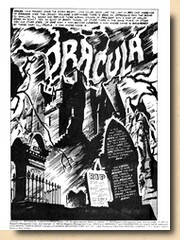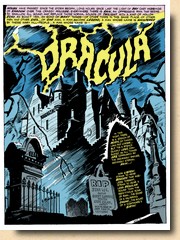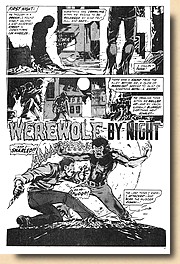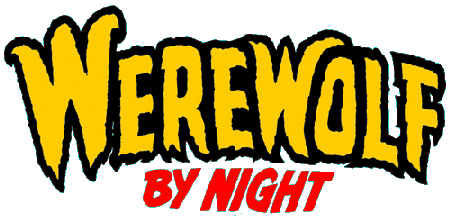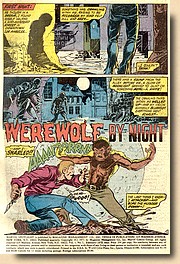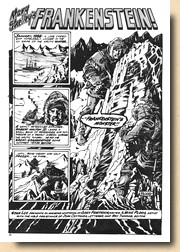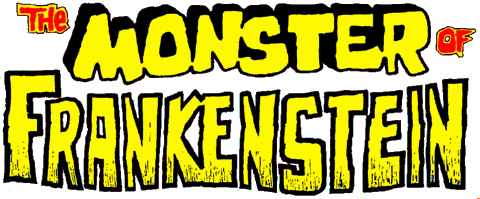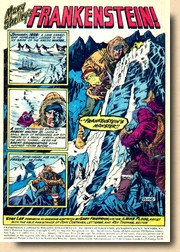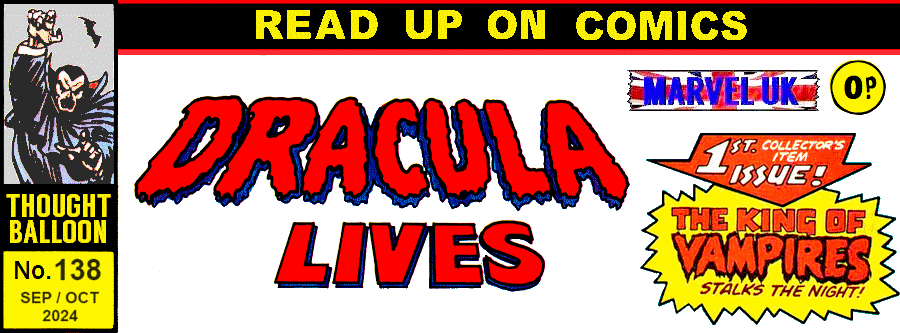 |
| |
MARVEL
UK's
DRACULA
LIVES #1
OCTOBER
1974
|
|
| |
DRACULA
"Dracula"
(First
13 of 25 pages from Tomb Of Dracula #1,
April 1972)
Story - Stan Lee & Roy Thomas (plot),
Gerry Conway (script)
Pencils & Inks - Gene Colan
Lettering - John Costanza
WEREWOLF
BY NIGHT
"Werewolf
By Night"
(8 pages)
(First 8
of 27 pages from Marvel Spotlight #2,
February 1972)
Story - Roy & Jeanie Thomas
(plot), Gerry Conway (script)
Pencils & Inks - Mike Ploog
Lettering - John Costanza
THE
MONSTER OF FRANKENSTEIN
"Mary
Shelley's Frankenstein"
(First
9 of 20 pages from Monster Of Frankenstein #1,
January 1973)
Story - Mary Shelley (original
story), Gary Friedrich (adaptation)
Pencils & Inks - Mike Ploog
Lettering - John Costanza
|
|
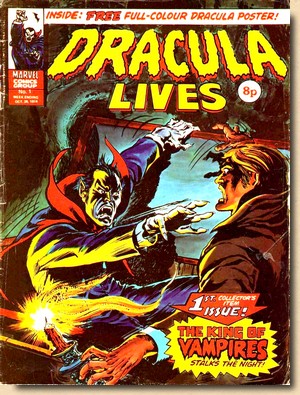 Dracula Lives Weekly
#1 (UK, 26 October 1973) Dracula Lives Weekly
#1 (UK, 26 October 1973)
Cover (pencils & inks) - Pablo
Marcos
|
|
| |
|
| |
THE MIGHTY WORLD OF
MARVEL (UK)
On the last Saturday of
September 1972, a new comic book appeared on British
newsagent stands. Cover dated "week ending Oct. 7,
1972",
Mighty World of Marvel #1 was published by Marvel under the
newly set up corporate name of Magazine Management London
Ltd, but the imprint would soon affectionately be
labelled "Marvel UK" both by fans and staff. It
started out with local editorial staff based at 120 Newgate Street in London,
but Marvel UK was, to all intents and purposes, launched
and initially directed out of Marvel's NYC offices.
|
| |
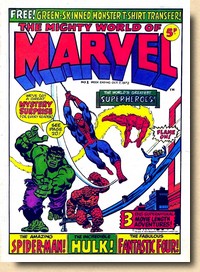
Mighty
World of Marvel #1
(7 October 1972)
|
|
The first
issue of Mighty World of Marvel (which
would soon acquire the affectionate acronym of MWOM)
started out with the origin stories of the Hulk,
the Fantastic Four and Spider-Man, and quickly
proved a huge success. It was thus only a little
more than four months and 19 issues after the
launch of MWOM that Marvel UK made its
next move to increase its share of the British
market by launching their second weekly on
February 10th 1973 - Spider-Man Comics Weekly (SMCW for short).
Aside from your
friendly neighbourhood web slinger now starring
in his own title, it introduced Thor as the
back-up feature, whilst Daredevil started out in
the pages of MWOM (taking the place of
Spider-Man), all adding yet more superheroes to
the growing ranks of Marvel UK. These were expanded further in
August 1973 when the Avengers were introduced in Mighty
World of Marvel #46. Both two weeklies were
selling extremely well, and it therefore wasn't
long until a third weekly title, along with more
Marvel characters, hit the news agents.
|
|
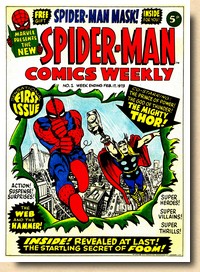
Spider-Man
Comics Weekly #1
(10 February 1973)
|
|
| |
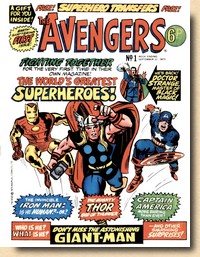
Avengers
#1
(22 September 1973)
|
|
Only a
mere month after having made their debut in the
pages of MWOM, the Avengers were moved
to their own title, with The Avengers (Weekly) #1 hitting the
UK's news stands the week ending on 22 September
1973. Earth's Mightiest Heroes were joined in
their own title by Doctor Strange, adding yet
another character to the growing ranks of Marvel
UK. Comic book readers in Britain
were now getting their real share of Merry
Marveldom - not only its superhero characters,
but also its visual house style along with its
friendly and chatty (often tongue-in-cheek, and
sometimes waaaay over the top) editorial style as
established by the Maestro Supreme Stan
Lee. The "Bullpen Bulletins" became a
feature of the UK weeklies as much as they were
an integral part of Marvel's US comic books, and
during the first two years of Marvel UK also
contained an anglicised version of Stan Lee's
famous "soapbox". It was there that readers of MWOM
#107 were told in mid-October 1974 that "we
are hurlin' a NEW MAG at ya".
Within
a fortnight, that statement turned out to be
something of an understatement, since Marvel UK
wasn't just launching one, but rather two new
weekly titles - and none of them superhero
themed, either: On 26 October 1974, the British
House of Ideas sent forth the first issues of Dracula
Lives and Planet of the Apes to news agents.
|
|
| |
|
| |
DRACULA LIVES!
Throughout
the 1960's "Silver Age", Marvel had
increasingly cultivated the concept of also
catering for the more mature comic book readers,
and as the 1970's "Bronze Age" rolled
around, this target group increasingly demanded
more than the classic superheroes.
Marvel
was more than happy to oblige and branched out
into other genres, and its range of horror characters played a substantial and
important role in this expansion.
Marvel's
most successful venture into the realm of horror
was Count Dracula, Bram Stoker's classic Lord of
Vampires. Given his own title straight away in April 1972, Tomb of Dracula ultimately ran for a total of 70
issues in the US - the longest run of any Bronze
Age Marvel horror genre title.
Tomb of
Dracula was therefore a a logical choice for
Marvel when it came to expanding its range of
weeklies in the UK. However, in a slightly
confusing move, the reprints of Tomb of
Dracula (the
extension to the vampire Count's name was
necessary for Marvel to be able to copyright the
title) were
launched in Great Britain under the title of Dracula
Lives - which was in fact the title of a
black and white magazine format comic book
featuring the count which Marvel was publishing
since June 1973.
|
|
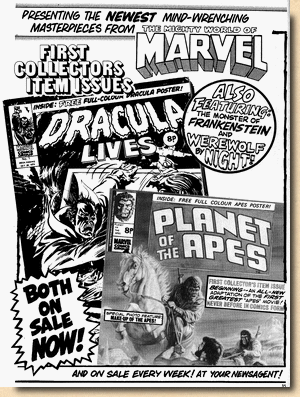
Avengers
#58
(26 October 1974)
|
|
| |
| A letter published in Dracula Lives #9
actually pointed out this very fact, but editorial simply
skipped over it, and the same procedure took place on the
letters page of Dracula Lives
#15. |
| |
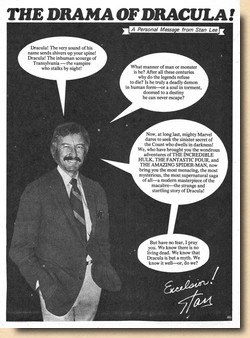
|
|
Ads in
Marvel UK's superheroes titles often heralded Dracula
Lives! and Planet of the Apes
together, and this "twinning" of the
two titles (which could often also be seen in the
letters from readers, commenting on both titles
at the same time) would continue right up until
the two weeklies were ultimately merged in June 1976. As had been customary for all
previous first issues of Marvel UK's weeklies, Dracula
Lives! contained a page featuring a
"personal message" from Stan Lee under
the heading of "The Drama of Dracula!".
Although the hyperbole was somewhat toned down
and replaced by classic spooky talk, it still
made for an excellent introduction - and sales
pitch for other characters featured in Marvel
UK's other weeklies.
The
UK comic book market of the early to mid-1970s
differed greatly from its counterpart in the US.
It was quintessentially keyed at a weekly
interval of publication, with predominantly black
and white contents, and multiple storylines and
different characters in one issue.
Marvel UK adapted
accordingly, and Dracula Lives therefore started
out with reprints of the very first stories
featuring Dracula, the Monster of Frankenstein, and Werewolf by Night.
|
|
| |
|
| |
|
| |
| The starring feature of Dracula Lives #1 was
made up of the first 13
of 25 pages from Tomb Of Dracula #1 (April
1972). The weekly publication cycle commonly prevented an
entire US issue to be reprinted in one UK mag, and the
original material was therefore edited into
weekly instalments. This created the lion's share of
editorial work, since it required newly crafted splash
pages to link the segments and extra covers alongside the
more conventional text editing. In theory, editorial
work for Dracula Lives #1 could thus have been
very minimal, but Marvel UK sometimes did the unexpected
in that department, and so rather than using Neal Adams'
cover for Tomb Of Dracula #1, Pablo Marcos pencilled and
inked a new one. Whatever the reasons (maybe it was
deemed more eye-catching?), the Adams cover was
eventually used (albeit-mirror imaged) for
Dracula Lives #4.
Somewhat more pedantic was the covering of the
original job number on the splash page (found in the
original on the foot of the headstone containing the
introductory text). Of course it only pertained to the
planing of the work that went into the original comic
book (Kleefeld, 2022), but editorial for Marvel Comics
reprints in different countries had different
perspectives and priorities. Germany's Williams Verlag,
for example, wiped the whole text from the tombstone and
only left the introductory text at the top of the page
for their
Gruft von Graf Dracula #1 in January 1974 -
yet managed to ignore that little "605-Z"
marking.
Somewhat major text editing was
applied to the last of the thirteen reprinted pages - for
good reasons.
|
| |
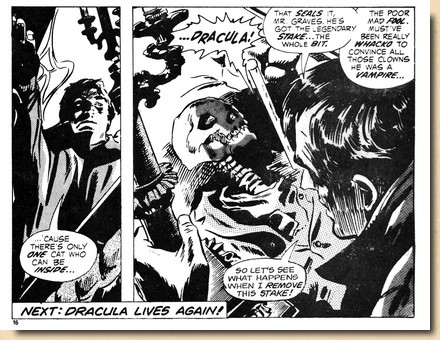
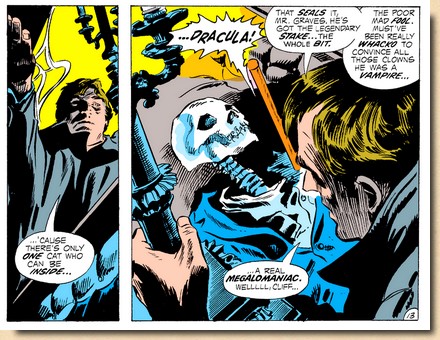
|
| |
| Gerry Conway had no
less than 25 pages at his disposal to start things moving
in Tomb Of Dracula #1 and introduce readers to the last living
descendant of Dracula, an American named Frank Drake, who has inherited the
ancestral castle. Together with his fiancee Jeanie and long-time friend
Clifton Graves he wants to stake out the possibilities of
making a fortune by opening the castle as a tourist
attraction. However, once at the castle they get
separated - and by the time Graves stumbles upon a coffin
with a staked skeleton (which surely must be Dracula),
the 13 pages of planned reprint material for Dracula
Lives #1 were used up. Albeit a fairly decent end of page
cliffhanger in its original form, this needed a little
extra punch in order to get readers excited about Dracula
Lives #2 - and so the page's original final word
balloon text ("... a real megalomaniac. Welllll,
Cliff...") was replaced by the far more ominous
"So let's see what happens when I remove
this stake!" - all suitably adorned with
the textbox "Next: Dracula lives again!".
|
| |
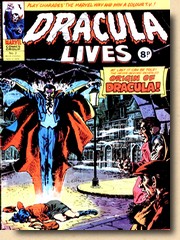 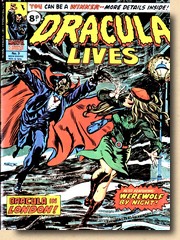 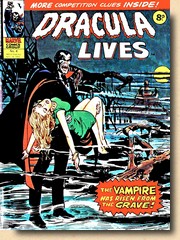 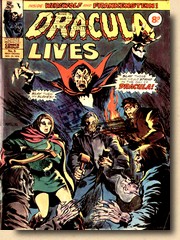 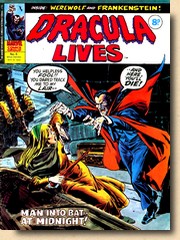 Covers of Dracula
Lives #2-6 showcasing a mix of original covers taken
from Tomb of Dracula (#2 John Severin, #4 Neal
Adams, #6 Gil Kane)
as well as new covers (#3 and #5) provided for the Marvel
UK title by Pablo Marcos
|
| |
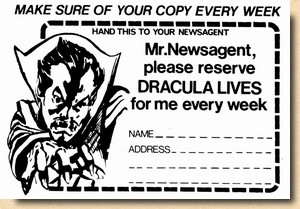
|
|
Tomb
of Dracula had originally been
planned as a black & white magazine
rather than a colour comic book, so in
that respect Dracula Lives was
somewhat close to the original's roots;
there are however diverging memories of
who did what in conjunction with Tomb
of Dracula #1. The
October 1971 Bullpen Bulletin credits
Stan Lee with plotting the first issue,
whereas Roy Thomas (Cooke, 2001)
remembers plotting that issue himself
based on just a few verbal sentences from
Lee, whilst Gerry Conway essentially
supplied captions and dialogue.
In any case,
the basic idea was to establish a direct
link between Bram Stoker's Victorian
novel Dracula and the current
time frame stories told in Tomb of
Dracula.
|
|
|
| |
| Gerry Conway inserted a number
of traits in that direction, ranging from a direct
reference to Stoker's novel by the locals of the village
overlooked by Castle Dracula ("Herr Stoker told
the truth - in part") to a nice full-page
introduction to the major themes and characters of Dracula. |
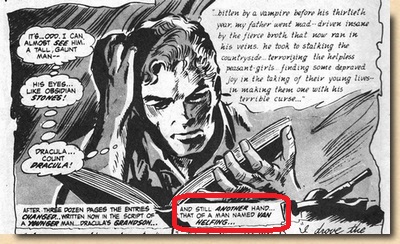
|
|
Unfortunately,
letterer John Costanza didn't seem to be
too aware of the traditional cast of
Dracula characters, and misspelt
"Van Helsing" as "Van
Helfing". This blunder also slipped
through Marvel UK's editorial net - and
incredibly enough still remained
uncorrected in the 2008 Omnibus reprint.
At least Panini got it right for their
2004 German language edition. 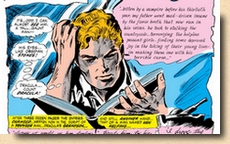 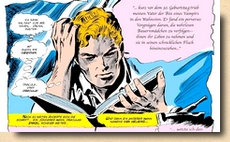
|
|
|
| |
| Youngster Archie Goodwin
followed Gerry Conway for issues #3-4 and was then
succeeded by veteran Gardner Fox for issues #5-6, before,
Marv Wolfman took over with Tomb of Dracula #7
and supplied the title with stable and top notch
storytelling for the rest of its run. |
| |
The artwork
was all done by Gene Colan, who created an
intensely atmospheric visual rendition of the
vampire Count's saga and established a look and
feel that went far beyond the classic horror
comic qualities.
"The
only strip I really begged for was Dracula.
[Stan Lee] promised it to me, but then he
changed his mind (...) But I didn't take that
for an answer. I worked up a page of Dracula
(...) and I sent it in. I got an immediate
call back. Stan said 'The strip is
yours'." (Gene Colan in
Thomas, 2000)
His
style provided readers with a truly captivating
visual journey into the dark shadows. Colan had
been a horror film buff his entire life and
deeply felt that comic books and movies share
common traits.
As for Dracula Lives
(which had acquired the additional title tag-line
Featuring The Legion of Monsters as of
issue #60 in mid-December 1975), the end came not
by way of a stake but in the shape and form of
the bleak UK economy of 1976, and a subsequently
struggling comics book market.
|
|
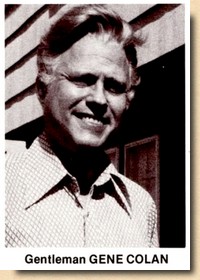
Gene Colan
in 1975
|
|
| |
| In June 1976 Dracula Lives
was cancelled as a weekly title and merged with Planet
of the Apes as of issue #88
on 16 June 1976. |
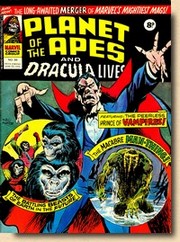 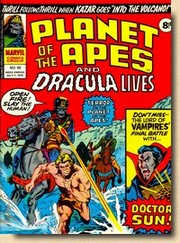 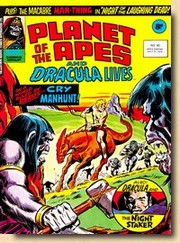
Planet
of the Apes and Dracula Lives #88, #90, #92
(23 June 1976, 7 July 1976, 21 July 1976)
|
|
It was not
the end of the Count, who would continue to
appear first in POTA (which then officially
became Planet of the Apes and Dracula Lives)
- although clearly as the backup feature, since
he never made it onto the cover of POTA for the
rest of that title's run after issue #88, apart
from two small cover vignettes (issues #90 and
#92). But not
only were the apes running the show, in spite of
the official title being Planet of the Apes
and Dracula Lives the vampire count actually
failed to make the line-up regularly as of POTA
#95. When Dracula did feature it was often only
to serve as a storyteller frame for old Atlas
monster stories (e.g. POTA #102).
|
|
| |
| Towards the end of its run
(which came with issue #123 in late February 1977), POTA
unceremoniously (and silently) phased out the
Transylvanian Count completely. But in spite of
everything, Dracula would still make a few occasional
appearances after that, in Marvel UK's flagship title, Mighty
World of Marvel. |
| |
|
| |
|
| |
| When Marvel
seriously started thinking about expanding into the
horror genre in late 1971, their first pick - somewhat
surprisingly - wasn't Dracula or Frankenstein's Monster,
but the classic Werewolf. |
| |
A creature
rooted in centuries of traditional folklore in
Europe and often portrayed as being innocent at
heart and suffering from an unhappy personal
fate, Marvel's version owed a lot to Roy Thomas
and his wife being bored at a car show:
"I had
this idea for something called "I,
Werewolf." I wanted it narrated in first
person (...) My wife Jeanie and I plotted the
first issue one day when we got bored with a
car show at Columbus Center in New York City,
but I didn't like to write that stuff, so I'd
always give assignments like that to Gerry
[Conway] (...) Stan [Lee] liked everything
but the title "I, Werewolf." He
wanted to call it Werewolf by Night, and
since all I cared about was the concept, not
the name, that was fine by me. It was still
narrated in the first person. I told Gerry to
do it that way, and it worked out very well.
Almost everything else after the first issue
(...) was pretty much Gerry's, I think."
(Cooke, 2001)
One of Marvel's most
successful horror characters, Werewolf by Night
made his first appearance in Marvel Spotlight
#2, one of the House of Ideas' try-out titles, in
February 1972.
|
|
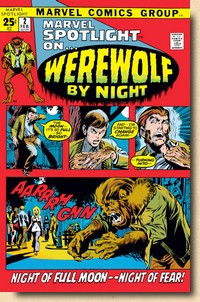 |
|
| |
| The series
focussed on Jack Russell, whose family (originally from
Eastern Europe) was cursed with lycanthropy. Starting on
his 18th birthday, Russell would find himself
transforming into a wolf-like creature every time there
was a full moon. Similar to Bruce Banner and the Hulk,
Jack Russell would always be seeking ways to either avoid
or at least control the transformations. Eventually he
would gain the ability to change into the werewolf at
will and control the beast, except on three specific
nights of the full moon. |
| |
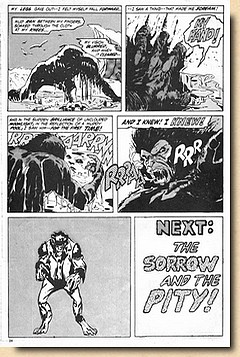 |
|
Initially
scripted by Gerry Conway and pencilled and inked
by Mike Ploog (who quickly became a fan
favourite), the character was well received and
liked by readers, earning the Werewolf by Night
his own comic book in September 1972, following
three appearances in Marvel Spotlight.
In the end, Werewolf
by Night turned out to be Marvel's second
most successful venture into the horror genre,
again making it a logical choice for Marvel UK's
Dracula
Lives.
As was the case
with the main Dracula feature, Conway had
originally had a very generous page count (no
less than 27) on his hands to introduce the
character and lay the groundwork. Dracula Lives #1 only
reprinted the first 8 of these, but since Conway
was moving things along rather quickly, UK
readers actually got to witness the first
werewolf transformation within this limited
amount of storytelling space.
|
|
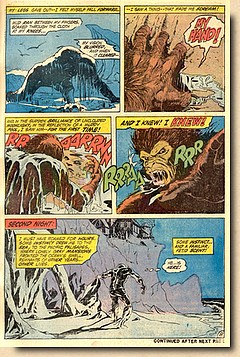 |
|
| |
| Conway's accelerated plot pacing even meant that
editorial had to put the brakes on when it came to the
last page to be reprinted in Dracula
Lives #1. In its original form, the bottom panel
takes readers to the second night of the full moon - not
an ideal way to end the story. Editorial therefore didn't
go past the first night's segment, left out the original
final panel of the page, and inserted a "next
issue" teaser instead. Readers of Dracula Lives
would never get to see that left out panel (the Werewolf
by Night feature would simply continue with the next page
from Marvel Spotlight #2, following a specially
produced and inserted "splash page"), but this
was how the reprints in Marvel UK's weeklies worked -
sometimes entire pages would get dropped (the various
editorial changes applied by Marvel UK are illustrated in
detail here). |
| |
| Although the weekly
publication cycle meant that Marvel UK was on average
burning through two original US issues per month (and
therefore catching up on newer material fast), the Werewolf by Night feature
running in Dracula Lives was actually ended
before the original material had been exhausted.
Cancelled in the US with issue #43 in March 1977,
the UK run ended in late
April 1976 in Dracula Lives #78, when Werewolf by Night was still
almost nine months ahead of Dracula Lives.
Originally billed as a "guest star", Ghost
Rider was here to stay and replaced the werewolf. |
| |
|
| |
|
| |
Following the extremely
successful launch of the two classic horror characters
Dracula and the Werewolf, Marvel introduced the
Frankenstein Monster with much ado in the January 1973 Bullpen Bulletin.
"We've
just got to clue you in to our own brand new
creature-feature, the comic-mag we call THE MONSTER
OF FRANKENSTEIN! With the unparalleled success of
WEREWOLF BY NIGHT and THE TOMB OF DRACULA, it was
impossible that we'd be able to resist the clarion
call to add the most famous gargoyle of all to the
mighty Marvel roster. And we've done it with a
vengeance, people! First off, we got our Werewolf
wonder-boy MIKE PLOOG to pencil - and monster-fan
first class GARY FRIEDRICH to script. Next, we
decided to do things up brown by being more faithful
to Mary Shelley's original masterpiece of suspense
than virtually any of the media have ever done
before! Pick up a copy and see what we mean, okay?
THE MONSTER OF FRANKENSTEIN - lumbering toward your
friendly neighborhood newsstand right now!"
It was Roy Thomas (editor-in-chief at the time) who
came up with the concept of adapting the original novel
in the first few issues and then take the plot from there
(Cooke, 2001), and assigned writer
Gary Friedrich thus started The Monster of
Frankenstein with a four-issue adaptation of Mary
Shelley's original novel.
|
| |
| What should have become another
strong player in Marvel's triumvirate of classic
horror (given its own title from the get-go)
would, however, turn out to be a less than
successful series which would only last for 18
issues. Nevertheless, it too was a logical
choice for the initial line-up of Marvel UK's Dracula Lives.
|
|
 |
|
| |
| Friedrich came up with a fairly ingenious framework to present the
basic corpus of Shelley's novel in flashback form, and
the adaptation was not only faithful to the original
literary work but remains one of the best in any media
form to this day. |
| |
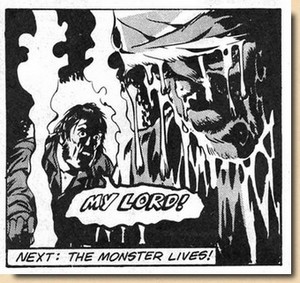
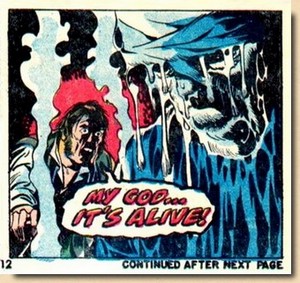 |
|
The
surprisingly literary approach - which steered
clear of almost all of the established routines
introduced by Universal's classic movies - is
partially explained by the fact that the
impression of Shelley's novel on assigned writer
Gary Friedrich was fresh.
"I had
never read the novel until Marvel decided to
do this. I was going to try to do it
faithfully, so I had to read the novel (...)
It is always tough to cut down a novel. There
are always things you would like to leave in
but something has to go. It probably took a
month or two to do the plot. The hardest part
was just figuring out how to break down the
plot." (Friedrich in N.N., 2008)
The result was well
worth the amount of time and thought invested.
But since readers of Dracula Lives #1
only got to read the first nine of twenty pages
from Monster Of Frankenstein #1, they
only just got a glimpse of the visual rendition
of the Monster - in the final panel of the last
reprinted page.
Victor
Frankenstein's cry of "My God... it's
alive!" (echoing Colin Clive in Universal's
1931 Frankenstein movie) was changed to
"My Lord!" (along with a a caption box
proclaiming "Next: The Monster lives!")
in order to avoid repetition, since the next page
featured the cover artwork of Monster of
Frankenstein #1, giving readers a first full
view of the Monster as well as its creator crying
out "It's alive! Heaven help me... it's
alive!".
However, as far as the
visuals of the Monster were concerned, there was
a problem: the classic Monster look everybody
knew (i.e. Boris Karloff wearing Jack Pierce's
make-up featuring a flat-top head, forehead scar,
and protruding bolts) was copyrighted (and
enforced) by Universal (Bailey, 2011). Stan Lee took no chances and
selected a proposal based on a sketch by John
Romita and fleshed out by Mike Ploog (Browning,
2009), who was the assigned artist for the first
six issues. The result didn't copy the Universal
visuals too closely and gave Marvel its very own
Monster look without straying too far from the
iconic Karloff mould.
|
|
| |
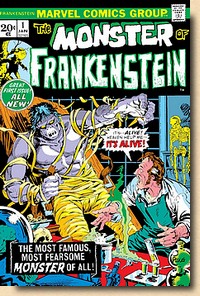 |
|
The fact that Marvel UK's weekly
titles were going through the original material
at an accelerated pace was a problem that sooner
or later literally caught up with all characters,
but it was greatly exacerbated if there wasn't
that much material to reprint in the first place. This
was certainly the case with Victor Frankenstein's
creation, since Monster
Of Frankenstein (retitled Frankenstein
Monster after five issues) only lasted for a
total of 18 issues in the US, and only spanned a
time frame from January 1973 to September 1975
because it was published bi-monthly for most of
its run.
According to Roy Thomas, the series ended
because sales weren't good enough after it had
initially sold well (Browning, 2009). As far as Dracula Lives was
concerned, running out of original material
coincided with the reprints having caught up.
|
|
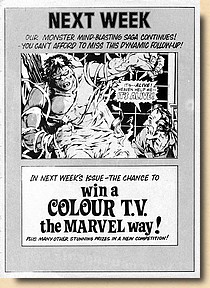 |
|
| |
| And so,
Marvel's tale of the Frankenstein Monster ended
the same way for readers in the US and the UK: with a story dangling in
mid-air. Without
any further ado, Dracula Lives #42 (9
August 1975) simply introduced The Living Mummy
as replacement. During
almost the entire run of Marvel's Frankenstein Monster
editorial made a number of glaring blunders and
generally seemed to be anything but on top of
things, adding a constant whiff of chaos to a
title already trying to gain a sense of balance
and direction. In an odd way, Marvel UK seemed to
want to replicate this by running an in-house
advert in Mighty World of Marvel #150
telling readers they could follow the mystery and
horror of Frankenstein's Monster in Dracula Lives - but by the time this
ad hit the news stands (16 August 1975), the
Living Mummy had already taken its place...
|
|
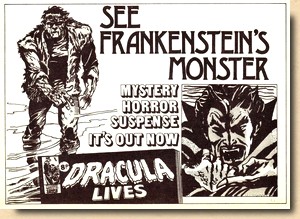
Mighty
World of Marvel #150
(16 August 1975)
|
|
| |
|
| |
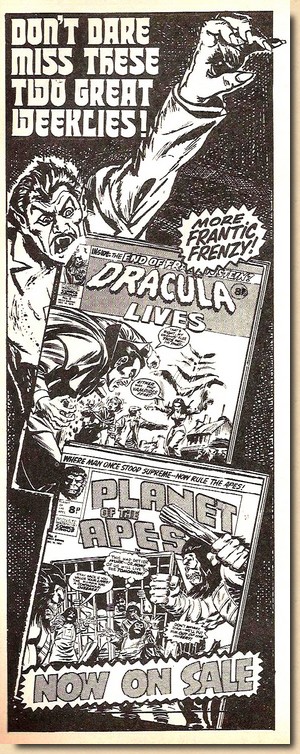
|
|

Just as the US originals
did, several pages of a Marvel UK weekly were
usually featured in-house advertising or
editorial (since this was the first issue, there
was no letters page as yet, and the UK Bullpen
Bulletin was a short stretch down the line too).
Dracula Lives
#1 had two pointers towards the second issue (one
featuring an actual view of the Frankenstein
Monster, given that the pages reprinted had just
cut that revelatory moment short, and another
telling readers about a competition and the
chance to win nothing less than a colour TV set),
along with the usual advertising for the
established three Marvel UK titles. The other new
weekly, Planet of the Apes, was given
the privilege of a plug in colour since it
appeared on the back cover.
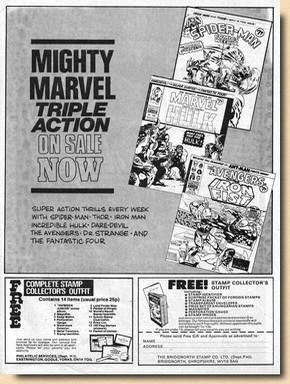 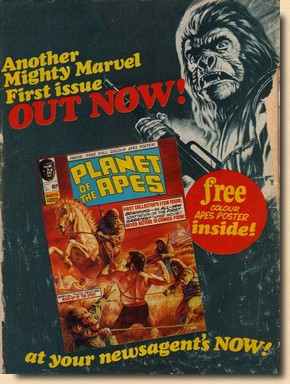
In-house adverts very
often were an excellent source of information
too, and would occasionally introduce readers to
Marvel characters they simply hadn't seen before.
|
|
| |
| Just as it had done in
the US, the horror genre went into a
steady and fast decline by the mid- to
late 1970s, and all that remains of the
one and only Marvel UK 1970s horror-only
title is but a ghostly spectre in the
form of now 40+ years old copies of Dracula
Lives - "Britain's no.1 fear
mag". 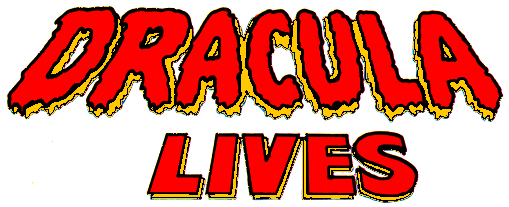
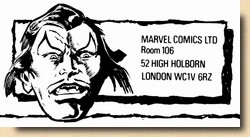
|
|
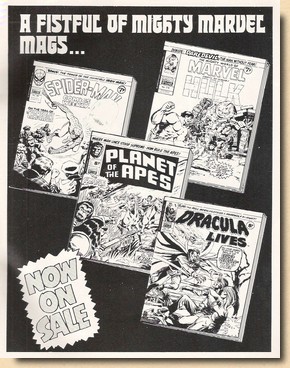
|
|
|
| |
|
| |
| FURTHER
READING ON THE THOUGHT
BALLOON |
| |
 |
|
There's
more on the 1970s history
of Marvel UK here,
and some closer looks at
specific titles and
issues here. |
|
|
|
|
| |
 |
|
You
can read more about
Marvel's 1970s Bronze Age
horror genre titles and
their "superheroes
from the crypt" here. |
|
|
|
|
| |
 |
|
There's
an issue-by-issue look at
the Tomb Of Dracula
series here. |
|
|
|
|
|
| |
 |
|
You
can read more about
Marvel's Frankenstein
Monster here. |
|
|
|
|
| |
 |
|
You
can read more about Gene
Colan here. |
|
|
|
|
| |
| |
|
| |
| BIBLIOGRAPHY BAILEY
Jonathan (2011) "How Universal
Re-Copyrighted Frankenstein’s Monster", PT Plagiarism Today, 24 October
2011
BROWNING
Michael (2009) "Flashback: The Monster of
Frankenstein", Back Issue! #36, Two Morrows
Publishing
COOKE Jon
B. (2001) "Son of Stan: Roy's Years of
Horror", Comic
Book Artist # 13, Two Morrows Publishing
KLEEFELD
Sean (2022) "Marvel Job Numbers", kleefeldoncomics.com,
16 February 2022
N. N.
(2008) "Gary Friedrich talks Frankenstein", www.comicmonsters.com,
no longer avilable
THOMAS Roy
(2000) "So you want a Job eh? The Gene
Colan Interview",
Alter Ego (vol. 3 issue 6)
|
| |
Uploaded to the
web 21 August 2024
Text is copyright (c) 2024

|
|
| |












